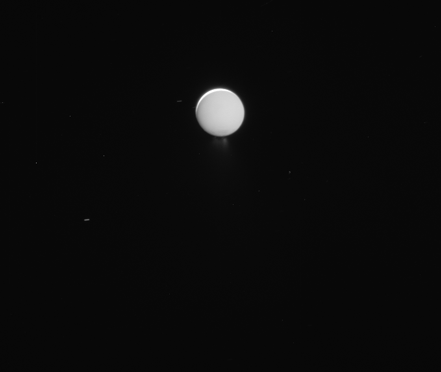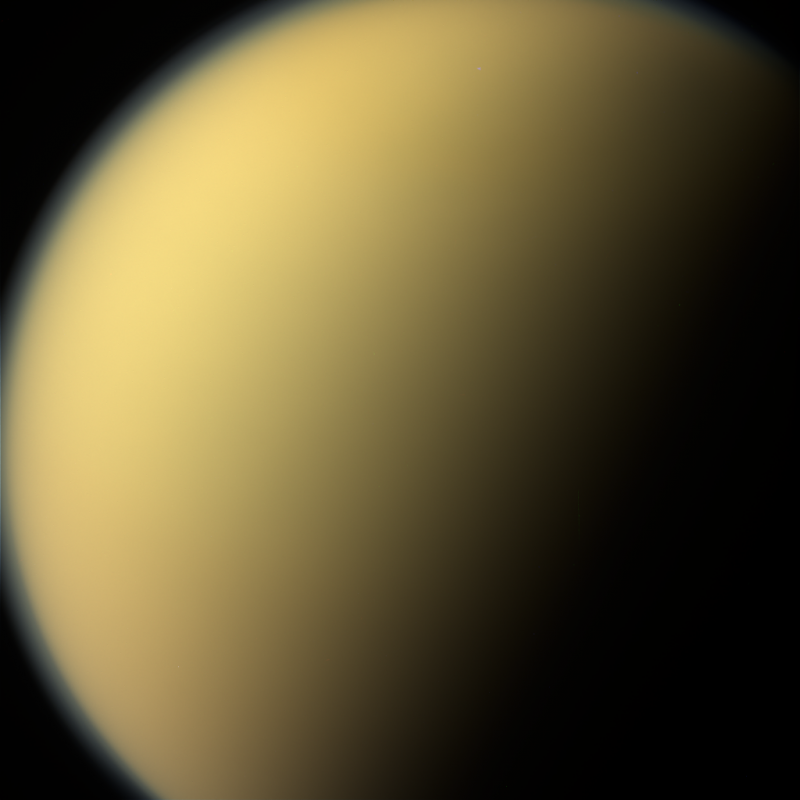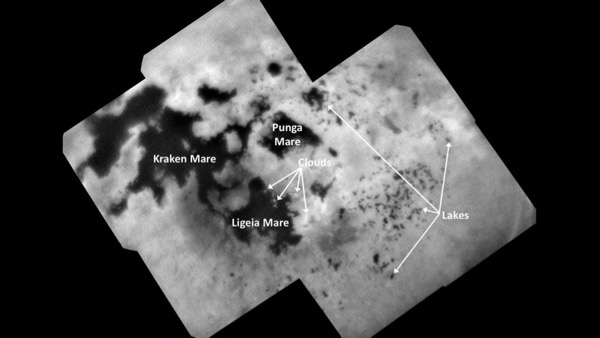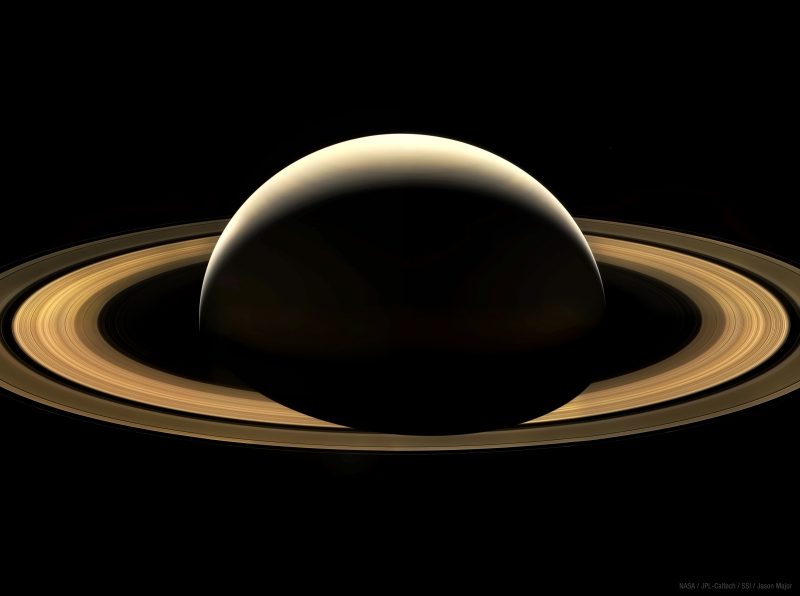
September 15, 2017. On this date, the Cassini spacecraft plunged into the planet Saturn, becoming part of the planet it had been orbiting since 2004.
The discoveries and new insights provided by the 13-year Cassini-Huygens mission at Saturn are far too numerous to recount here. But we can say that Cassini – fourth earthly space probe ever to visit Saturn and first to enter its orbit – revolutionized the way we on Earth think about Saturn and its moons and rings. It also dramatically altered the way we perceive nature generally in the great outer neighborhood of our solar system, as spectacular image after image just kept coming, all the way to the mission’s final days.
In its 13 years at Saturn, Cassini acquired one of the most beautiful collections of spacecraft images that has ever been assembled. Visit a Cassini image gallery.

Movie sequence of images from the last dedicated observation of Saturn’s moon Enceladus – and its water plume, which rains onto Saturn itself – by Cassini on August 28, 2017. Read more about this image via ESA.

Cassini’s last look at Saturn’s large moon, Titan, acquired September 13, 2017, just 2 days before the spacecraft’s final plunge. This world is covered by a dense haze. Cassini and its Huygens lander let scientists peer beneath the haze for the first time. Among other things, we now know that Titan has liquid lakes and seas, not made of water, but of liquid methane and ethane. Read more.

A last look Titan’s north polar landscape of lakes and seas, filled with liquid methane and ethane, captured by Cassini on September 11, 2017. Four days later, the craft was deliberately plunged into Saturn’s atmosphere. Read more about this image.
Ultimately, Cassini ran out of fuel. The mission had to end. But the craft’s year-long Grand Finale was also incredibly dramatic. The craft was maneuvered to pass close to Saturn and many of its moons, sweeping closer than it had dared in previous years of the mission, and ultimately to dive repeatedly through the narrow gap between the body of Saturn and its innermost rings.
Cassini made 22 weekly dives between the inner rings and Saturn’s outer clouds, beginning in late April, 2017. No spacecraft had ever ventured so close to the planet before.
Cassini’s last images were sent back to Earth on September 14, 2017, the day before the plunge into Saturn.

One of Cassini’s final images of Saturn’s rings. Visit a Cassini image gallery.
Even during its final moments, Cassini made the deepest-ever measurements of the plasma density, magnetic field, temperatures and atmospheric composition in Saturn’s atmosphere.
The intentional plunge into the planet had the goal of ensuring that Saturn’s icy moons – in particular ocean-bearing Enceladus – would not risk being contaminated by microbes that might have remained on board the spacecraft from Earth.
During its dive into the atmosphere, the spacecraft’s speed was approximately 70,000 miles (113,000 km) per hour. The final plunge took place on the day side of Saturn, near local noon, with the spacecraft entering the atmosphere around 10 degrees north latitude.
The spot: an infrared image of the location where the spacecraft entered Saturn's atmosphere https://t.co/0tzUxxS2BW #Cassini pic.twitter.com/AXedtqKpBR
— CassiniSaturn (@CassiniSaturn) September 15, 2017
Atmospheric entry into Saturn began about a minute and a half before the final loss of signal. When Cassini first began to encounter Saturn’s atmosphere, the spacecraft’s attitude control thrusters began firing in short bursts to work against the thin gas and keep Cassini’s saucer-shaped high-gain antenna pointed at Earth to relay the mission’s precious final data.
As the atmosphere thickened, the thrusters were forced to ramp up their activity, going from 10 percent of their capacity to 100 percent in the span of about a minute.
Once they were firing at full capacity, the thrusters could do no more to keep Cassini stably pointed, and the spacecraft began its final tumble. Cassini survived for a total of 91 seconds in Saturn’s dense atmosphere, before tipping over backward during its last eight seconds and finally losing radio contact with Earth.
The mission was over, as the probe succumbed to the increasing heat and pressure.
Read more: Reliving Cassini’s final moments
Earth received @CassiniSaturn’s final signal at 7:55am ET. Cassini is now part of the planet it studied. Thanks for the science #GrandFinale pic.twitter.com/YfSTeeqbz1
— NASA (@NASA) September 15, 2017
Cassini’s last transmissions were received by antennas at NASA’s Deep Space Network complex in Canberra, Australia. Confirmation of the end of the 20-year Cassini mission at Saturn arrived at NASA’s Jet Propulsion Laboratory at 7:55 a.m. EDT (11:55 UTC) on September 15, 2017. The loss of the spacecraft’s signal had occurred 83 minutes earlier at Saturn, which was nearly a billion miles (some 1.4 billion km) from Earth at the time.
The spacecraft’s fateful dive into the planet itself was the final beat in the mission’s Grand Finale. For its coverage of the Cassini mission’s Grand Finale at Saturn, NASA’s Jet Propulsion Laboratory won an Emmy Award for Outstanding Original Interactive Program. The Academy of Television Arts & Sciences presented the award on Saturday, September 8, 2018. Read more: And the Emmy goes to Cassini’s Grand Finale
Look back in wonder: some of our final views of Saturn https://t.co/h01rZn8mvY pic.twitter.com/FXym30DUOy
— CassiniSaturn (@CassiniSaturn) September 15, 2017
The Cassini-Huygens mission launched on October 15, 1997, as a collaboration between NASA, the European Space Agency (ESA), and the Italian Space Agency. The spacecraft took six years and 261 days to travel to Saturn – flying past multiple objects in our solar system – finally entering orbit around Saturn on July 1, 2004. Saturn is a gaseous, giant planet; when we look at it, we’re seeing the tops of its clouds. But Saturn’s largest moon, Titan, had also long been fascinating to scientists. The Huygens lander set down on Titan’s surface on January 1, 2005.
Afterwards, the Cassini orbiter continued to orbit Saturn, weaving among the planet’s many moons for year after year.
Every time we see Saturn in the night sky, we'll remember. We'll smile. And we'll want to go back. #GrandFinale #GoodbyeCassini #Cassini pic.twitter.com/6tzJ4N9Jif
— CassiniSaturn (@CassiniSaturn) September 15, 2017
The Cassini mission was meant to last three years in orbit around Saturn, and instead the spacecraft spent 13 years, 76 days, orbiting Saturn. It gave us wonders to the end. It is missed!
A NASA e-book, “The Saturn System Through the Eyes of Cassini,” showcasing compelling images and key science discoveries from the mission, is available here, for free download, in multiple formats.

Artist’s concept of Cassini’s end of mission, via NASA.
Bottom line: Click here for links to the last few raw images gathered by Cassini prior to its plunge into Saturn on September 15, 2017, and to learn how to follow the mission’s end online.
End of Cassini mission timeline
from EarthSky https://ift.tt/2OkYS8a

September 15, 2017. On this date, the Cassini spacecraft plunged into the planet Saturn, becoming part of the planet it had been orbiting since 2004.
The discoveries and new insights provided by the 13-year Cassini-Huygens mission at Saturn are far too numerous to recount here. But we can say that Cassini – fourth earthly space probe ever to visit Saturn and first to enter its orbit – revolutionized the way we on Earth think about Saturn and its moons and rings. It also dramatically altered the way we perceive nature generally in the great outer neighborhood of our solar system, as spectacular image after image just kept coming, all the way to the mission’s final days.
In its 13 years at Saturn, Cassini acquired one of the most beautiful collections of spacecraft images that has ever been assembled. Visit a Cassini image gallery.

Movie sequence of images from the last dedicated observation of Saturn’s moon Enceladus – and its water plume, which rains onto Saturn itself – by Cassini on August 28, 2017. Read more about this image via ESA.

Cassini’s last look at Saturn’s large moon, Titan, acquired September 13, 2017, just 2 days before the spacecraft’s final plunge. This world is covered by a dense haze. Cassini and its Huygens lander let scientists peer beneath the haze for the first time. Among other things, we now know that Titan has liquid lakes and seas, not made of water, but of liquid methane and ethane. Read more.

A last look Titan’s north polar landscape of lakes and seas, filled with liquid methane and ethane, captured by Cassini on September 11, 2017. Four days later, the craft was deliberately plunged into Saturn’s atmosphere. Read more about this image.
Ultimately, Cassini ran out of fuel. The mission had to end. But the craft’s year-long Grand Finale was also incredibly dramatic. The craft was maneuvered to pass close to Saturn and many of its moons, sweeping closer than it had dared in previous years of the mission, and ultimately to dive repeatedly through the narrow gap between the body of Saturn and its innermost rings.
Cassini made 22 weekly dives between the inner rings and Saturn’s outer clouds, beginning in late April, 2017. No spacecraft had ever ventured so close to the planet before.
Cassini’s last images were sent back to Earth on September 14, 2017, the day before the plunge into Saturn.

One of Cassini’s final images of Saturn’s rings. Visit a Cassini image gallery.
Even during its final moments, Cassini made the deepest-ever measurements of the plasma density, magnetic field, temperatures and atmospheric composition in Saturn’s atmosphere.
The intentional plunge into the planet had the goal of ensuring that Saturn’s icy moons – in particular ocean-bearing Enceladus – would not risk being contaminated by microbes that might have remained on board the spacecraft from Earth.
During its dive into the atmosphere, the spacecraft’s speed was approximately 70,000 miles (113,000 km) per hour. The final plunge took place on the day side of Saturn, near local noon, with the spacecraft entering the atmosphere around 10 degrees north latitude.
The spot: an infrared image of the location where the spacecraft entered Saturn's atmosphere https://t.co/0tzUxxS2BW #Cassini pic.twitter.com/AXedtqKpBR
— CassiniSaturn (@CassiniSaturn) September 15, 2017
Atmospheric entry into Saturn began about a minute and a half before the final loss of signal. When Cassini first began to encounter Saturn’s atmosphere, the spacecraft’s attitude control thrusters began firing in short bursts to work against the thin gas and keep Cassini’s saucer-shaped high-gain antenna pointed at Earth to relay the mission’s precious final data.
As the atmosphere thickened, the thrusters were forced to ramp up their activity, going from 10 percent of their capacity to 100 percent in the span of about a minute.
Once they were firing at full capacity, the thrusters could do no more to keep Cassini stably pointed, and the spacecraft began its final tumble. Cassini survived for a total of 91 seconds in Saturn’s dense atmosphere, before tipping over backward during its last eight seconds and finally losing radio contact with Earth.
The mission was over, as the probe succumbed to the increasing heat and pressure.
Read more: Reliving Cassini’s final moments
Earth received @CassiniSaturn’s final signal at 7:55am ET. Cassini is now part of the planet it studied. Thanks for the science #GrandFinale pic.twitter.com/YfSTeeqbz1
— NASA (@NASA) September 15, 2017
Cassini’s last transmissions were received by antennas at NASA’s Deep Space Network complex in Canberra, Australia. Confirmation of the end of the 20-year Cassini mission at Saturn arrived at NASA’s Jet Propulsion Laboratory at 7:55 a.m. EDT (11:55 UTC) on September 15, 2017. The loss of the spacecraft’s signal had occurred 83 minutes earlier at Saturn, which was nearly a billion miles (some 1.4 billion km) from Earth at the time.
The spacecraft’s fateful dive into the planet itself was the final beat in the mission’s Grand Finale. For its coverage of the Cassini mission’s Grand Finale at Saturn, NASA’s Jet Propulsion Laboratory won an Emmy Award for Outstanding Original Interactive Program. The Academy of Television Arts & Sciences presented the award on Saturday, September 8, 2018. Read more: And the Emmy goes to Cassini’s Grand Finale
Look back in wonder: some of our final views of Saturn https://t.co/h01rZn8mvY pic.twitter.com/FXym30DUOy
— CassiniSaturn (@CassiniSaturn) September 15, 2017
The Cassini-Huygens mission launched on October 15, 1997, as a collaboration between NASA, the European Space Agency (ESA), and the Italian Space Agency. The spacecraft took six years and 261 days to travel to Saturn – flying past multiple objects in our solar system – finally entering orbit around Saturn on July 1, 2004. Saturn is a gaseous, giant planet; when we look at it, we’re seeing the tops of its clouds. But Saturn’s largest moon, Titan, had also long been fascinating to scientists. The Huygens lander set down on Titan’s surface on January 1, 2005.
Afterwards, the Cassini orbiter continued to orbit Saturn, weaving among the planet’s many moons for year after year.
Every time we see Saturn in the night sky, we'll remember. We'll smile. And we'll want to go back. #GrandFinale #GoodbyeCassini #Cassini pic.twitter.com/6tzJ4N9Jif
— CassiniSaturn (@CassiniSaturn) September 15, 2017
The Cassini mission was meant to last three years in orbit around Saturn, and instead the spacecraft spent 13 years, 76 days, orbiting Saturn. It gave us wonders to the end. It is missed!
A NASA e-book, “The Saturn System Through the Eyes of Cassini,” showcasing compelling images and key science discoveries from the mission, is available here, for free download, in multiple formats.

Artist’s concept of Cassini’s end of mission, via NASA.
Bottom line: Click here for links to the last few raw images gathered by Cassini prior to its plunge into Saturn on September 15, 2017, and to learn how to follow the mission’s end online.
End of Cassini mission timeline
from EarthSky https://ift.tt/2OkYS8a


Aucun commentaire:
Enregistrer un commentaire